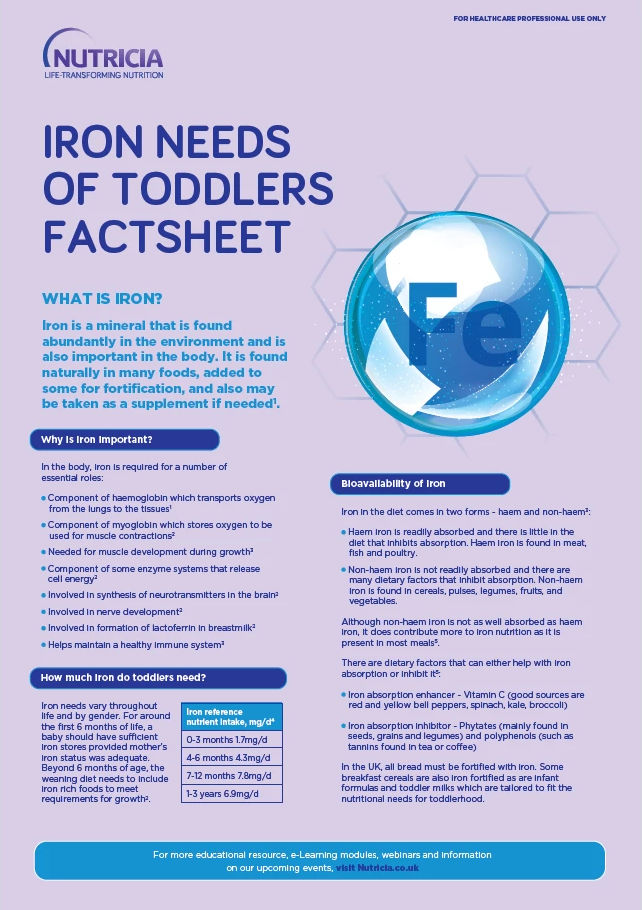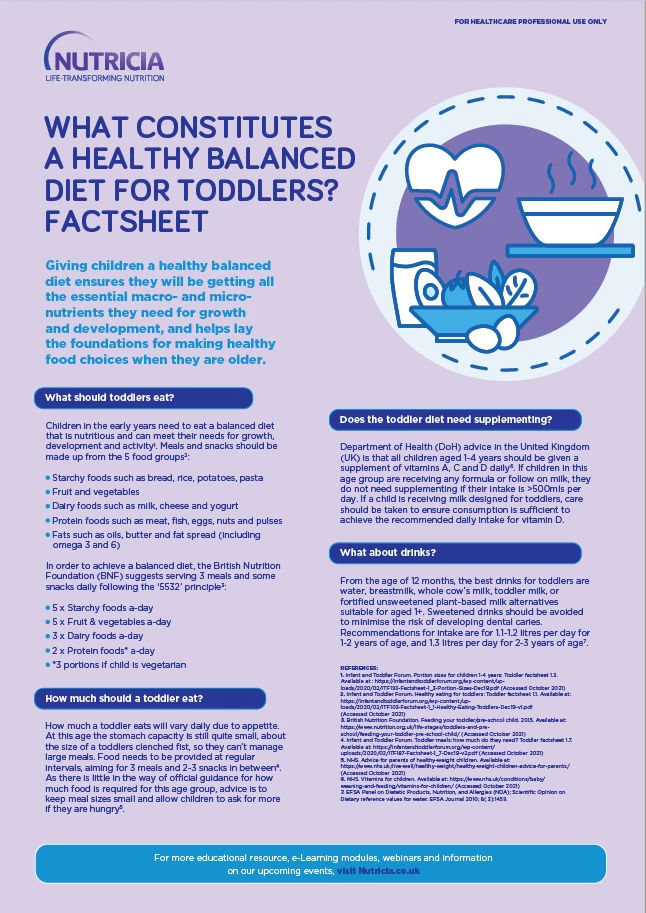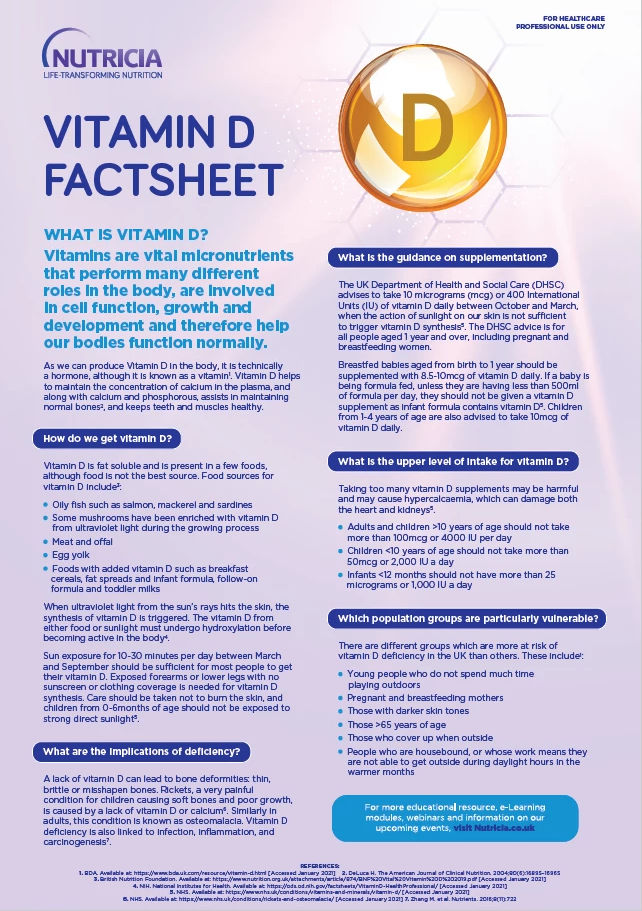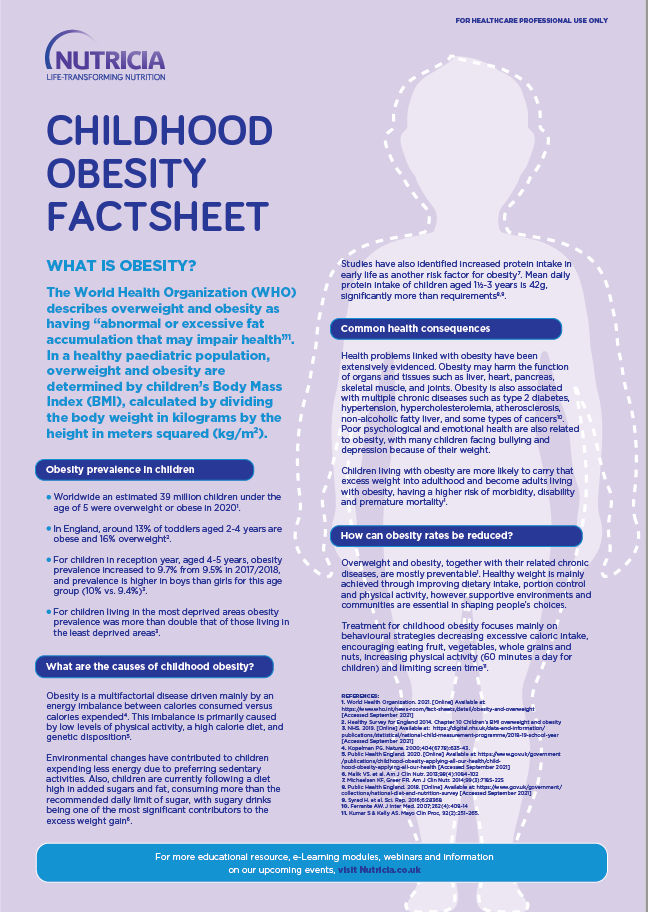Following weaning, the toddler years are an important time for the adoption of a healthy diet, however it is at this stage when food preferences are becoming established, and children begin to have a decisive say in what they eat. The food likes and dislikes of young children can represent a significant barrier to achieving a nutritionally complete and balanced diet.
Studies have shown that early exposure to foods and indeed the manner in which food is presented are key determining factors in whether the toddler will accept it. For example, it is important to remember that infants and toddlers have an innate preference for sweet tasting foods in favour of the more nutrient rich water based foods such as vegetables. It can also take many times, as much as 10 times or more before a new food is accepted (Birch 1982) so it is important that parents are encouraged to persevere.
Hear from Dietitian and Nutritionist; Sarah Almond Bushell
Toddlers benefit from a regular routine of meal and snack occasions throughout the day. Factoring these in around their sleep times allows them to get regular nutritious top ups while not becoming over hungry. A daily routine of 3 meals and 2 snacks, all with nutritious foods is recommended, along with encouraging toddlers to enjoy their food (ITF 1.1).
Toddlers should ideally have the following food portions per day (BNF):
· Starchy foods x 5-a-day
· Fruit & vegetables x 5-a-day
· Dairy foods x 3-a-day
· Protein foods x 2-a-day (or 3 portions for vegetarian children)
· And for fluids, 6-8 drinks per day (preferably water and milk, rather than sugar-sweetened drinks or juice)
Following the recommended meal and snack routine should provide toddlers with the energy they need and a wide range of micronutrients (ITF 1.1) if nutritious foods are given.
It is important to remember that all children aged 1 to 4 years old should be given a daily supplement containing 10 micrograms (mcg) of vitamin D throughout the year (NHS). As well as vitamin D, guidelines say there are other key nutrients that can be difficult for toddlers to get all of their recommended intakes from their diet alone, such as iron and Omega-3 fats (FSAI).
The UK Government advises that babies and young children should be having supplements to their diet of vitamins A, C and D. Some families on low incomes may be eligible for free vitamin drops under the Healthy Start scheme. If families are buying their own supplements, care should be taken to make sure they meet the recommended levels as around 2/3 of supplement products available to buy don’t contain enough vitamin D to meet the guidelines for children >6m (Moon 2020).
Vitamin D
Government advice is that breastfed babies, and formula-fed babies if they are having <500ml of formula per day, from birth to 1 year of age should be supplemented with 8.5-10mcg vitamin D daily (NHS vitamin D).
For children aged 1-4 years old, they should have their diet supplemented with 10mcg vitamin D every day, all year round (NHS vitamin D). The most recent National Diet and Nutrition Survey (NDNS 2020) data showed that only 25% of children aged 1.5-3 years are taking vitamin D supplements.
Vitamin D helps to maintain the concentration of calcium in the plasma, and along with calcium and phosphorous, assists in maintaining normal bones (DeLuca 2004), and keeps teeth and muscles healthy. It is predominantly synthesised by the action of sunlight on the skin and is hard to get in sufficient amounts from food.
Vitamins A & C
Further to the above recommendation, Government advises all children aged 1-4 years old should also be supplemented with vitamins A and C, all year round (unless taking >500mls formula per day).
Vitamin A is needed for a healthy immune system, good night vision and healthy skin (NHS vitamins for children). The daily requirement for vitamin A for 1-3 year olds is 400mcg (HMSO 1991).
Vitamin C is needed for general health and immunity, and helps the body absorb iron (NHS vitamins for children). The daily requirement for vitamin C for 1-3 year olds is 30 milligrams (mg) (HMSO 1991).
Iron
Iron is also a hard to get nutrient for many toddlers. The most recent NDNS data showed that 11% of toddlers had iron intakes below the lower reference nutrient intake (LRNI) (NDNS 2020), which is a marked increase from 5% in 2010. NDNS data also showed that >50% of toddlers aren’t achieving the daily reference nutrient intake (RNI) for iron (NDNS 2020), so it is clear that many are not getting sufficient amounts.
Iron is important for making red blood cells which transport oxygen around the body (NHS iron). Children aged 1-3 years need 6.9mg per day (HMSO 1991).
Omega-3
Guidelines say that Omega-3 fat can often be inadequate in the diet of toddlers (FSAI, Hojsak 2018). Omega-3 fats are a group of fats that include Alpha-Linoleic Acid (ALA) which is a dietary essential and from which long-chain Omega-3 fats can be made. The long-chain types are Eicosapentaenoic Acid (EPA) and Docosahexaenoic Acid (DHA). In infants, DHA is important for retina and brain development (BDA 2021).
Downloads and factsheets for healthcare professionals to use with patients
- Nicklaus, S. et al. A Prospective Study of Food Preferences in Childhood. Food Quality and Preference 2004;15: 805-818.
- Birch LL and Marlin DW. I don’t like it, I never tried it: Effects of exposure to food on two year old children preferences. Appetite 1982;3:353-360
- Cowbrough, Kathy. (2010). Feeding the toddler: 12 months to 3 years--challenges and opportunities. The journal of family health care. 20. 49-52.
- Infant and Toddler Forum. Healthy Eating for Toddlers. Toddler Factsheet 1.1 (2018). Available at: https://infantandtoddlerforum.org/wp-content/uploads/2020/02/ITF103-Factsheet-1_1-Healthy-Eating-Toddlers-Dec19-v1.pdf (Accessed August 2021)
- British Nutrition Foundation. Nutrition for toddlers. (2018). Available at: https://www.nutrition.org.uk/healthyliving/toddlers/249-feeding-your-toddlerpre-school-child.html?limit=1&start=1 (Accessed August 2021)
- NHS. Vitamin D. Available at: https://www.nhs.uk/conditions/vitamins-and-minerals/vitamin-d/ (Accessed August 2021)
- FSAI: Scientific Recommendations for Food-Based Dietary Guidelines for 1 to 5 Year-Olds in Ireland (2020). Available at: https://www.fsai.ie/news_centre/press_releases/healthy_eating_1-5yearolds_22062020.html (Accessed August 2021)
- DeLuca H. Overview of general physiologic features and functions of vitamin D. The American Journal of Clinical Nutrition. 2004;80(6):1689S–1696S
- Moon RJ, Curtis EM, Cooper C, Davies JH, Harvey NC. Vitamin D supplementation: are multivitamins sufficient?. Arch Dis Child. 2020;105(8):791-793
- NHS. Vitamins for children. Available at: https://www.nhs.uk/conditions/baby/weaning-and-feeding/vitamins-for-children/ (Accessed August 2021)
- HMSO. Dietary Reference Values for Food Energy and Nutrients for the United Kingdom. HMSO 1991; Report on Health and Social Subjects 411991.
- National Diet and Nutrition Survey (NDNS) Rolling programme Years 9 to 11 (2016/2017 to 2018/2019). Public Health England and the Food Standards Agency (2020). Available at: https://www.gov.uk/government/statistics/ndns-results-from-years-9-to-11-2016-to-2017-and-2018-to-2019 (Accessed August 2020)
- NHS. Iron (2020). Available at: https://www.nhs.uk/conditions/vitamins-and-minerals/iron/ (Accessed August 2021)
- BDA. Omega-3: Food Fact Sheet. (2021). Available at: https://www.bda.uk.com/resource/omega-3.html (Accessed August 2021)
- Hojsak I. et al. ESPGHAN Committee on Nutrition Young Child Formula: A Position Paper by the ESPGHAN Committee on Nutrition. Journal of Pediatric Gastroenterology and Nutrition: January 2018;66(1):177-185
- NHS. Your baby's first solid foods. (2019). Available at: https://www.nhs.uk/conditions/baby/weaning-and-feeding/babys-first-solid-foods/ (Accessed August 2021)
- ESPGHAN Committee on Nutrition. Complementary feeding: a commentary by the ESPGHAN committee on nutrition. J Pers Soc Psychol. 2008;46:99-110.
- NHS Start4life. Ready or not? Available at: https://www.nhs.uk/start4life/weaning/ready-or-not/ (Accessed August 2021)
- Barends, C. et al. Effects of Repeated Exposure to Either Vegetables or Fruits on Infant’s Vegetable and Fruit Acceptance at the Beginning of Weaning. Food Quality and Preference 2013;29: 157-165
- Fildes. A. et al. Early Exposure to Vegetable Variety on Infants’ Like and Consumption. The TASTE intervention study. Appetite 2014;76: 210.
- Gerish, C.J. & Mennella, J.A. Flavor Variety Enhances Food Acceptance in Formula-fed Infants. American Journal of Clinical Nutrition 2001;73(6): 1080-1085.
- Maier, A. et al. Effects of Repeated Exposure on Acceptance of Initially Disliked Vegetables in 7-month Old Infants. Food Quality and Preference 2007;18(8): 1023-1032.
- Hetherington M. et al. A step-by-step introduction to vegetables at the beginning of complementary feeding. The effects of early and repeated exposure. Appetite 2015;84;280-290







